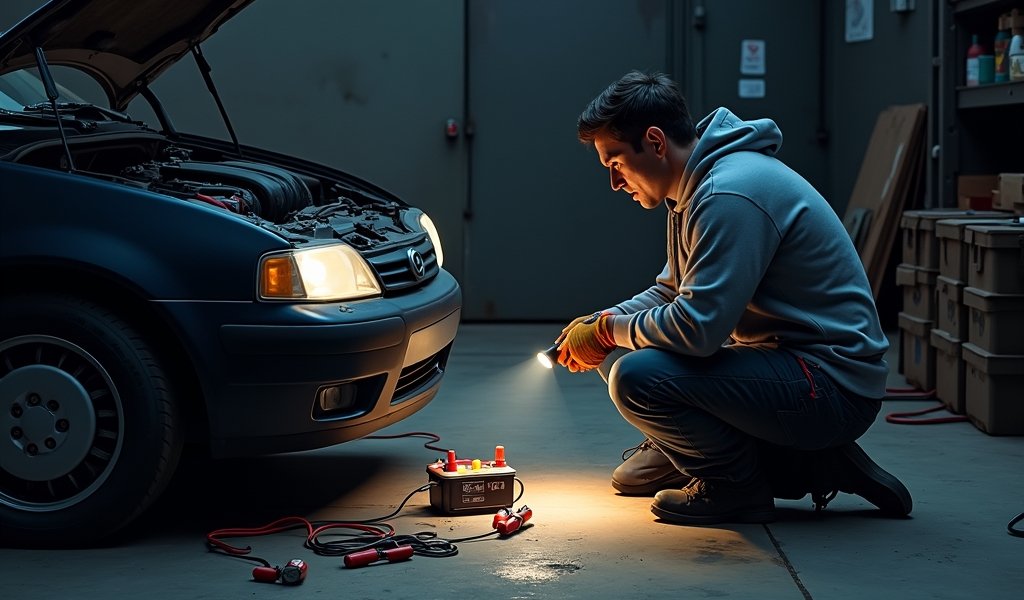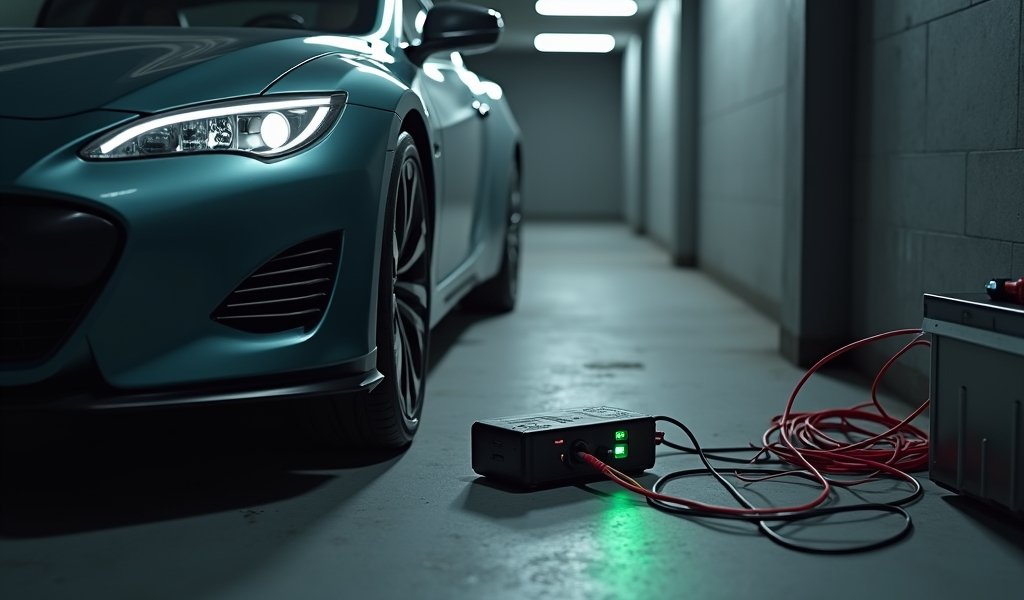Overview
Battery maintainers are essential for preventing damage during vehicle storage by counteracting natural discharge and parasitic drain, unlike regular chargers which can overcharge batteries. When choosing a maintainer, consider your specific battery type, ensure proper connection, and implement additional storage practices like cleaning terminals and controlling storage temperature to maximize battery life and ensure your vehicle starts immediately when needed.
Table of Contents
- Why Your Battery Needs a Maintainer During Storage
- How Car Batteries Discharge When Not in Use
- Battery Maintainers vs. Regular Chargers: What’s the Difference?
- Choosing the Right Battery Maintainer for Your Vehicle
- How to Properly Use a Battery Maintainer
- Additional Battery Storage Tips from the Pros
- Special Considerations for Different Vehicles
- Conclusion
- Frequently Asked Questions
Why Your Battery Needs a Maintainer During Storage
Let me tell you something I’ve seen hundreds of times in my garage: a customer comes in with a vehicle that’s been sitting unused for months, and they’re baffled why it won’t start. Nine times out of ten, it’s a dead battery. And the kicker? It could have been easily prevented with a car battery maintainer for storage.
When vehicles sit idle for extended periods—whether it’s your summer convertible during winter months, an RV between camping seasons, or even your daily driver during a long vacation—your battery slowly loses its charge. This isn’t just an inconvenience; it can actually damage the battery permanently.
What most folks don’t realize is that modern vehicles continuously draw small amounts of power even when they’re off. Your car’s clock, alarm system, and computer modules all quietly sip electricity. This “parasitic drain” might seem insignificant, but over weeks or months, it adds up to a serious problem.
A quality battery maintainer is essentially your battery’s best friend during storage. It delivers just enough power to counteract that drain and keep your battery at its optimal charge level—not too high, not too low, but just right. Think of it as a personal battery babysitter that works 24/7.
I’ve seen proper battery maintenance extend a battery’s life by years, while neglect can kill even the best batteries in just a few months. Let’s dive into everything you need to know about keeping your battery healthy during those downtime periods.
How Car Batteries Discharge When Not in Use
Even sitting perfectly still, your car battery is never truly “at rest.” All batteries naturally self-discharge due to chemical reactions happening inside them. It’s just physics—you can’t fight it, but you can manage it.
For a typical 12-volt car battery, you can expect to lose about 0.1 volts per week. That might not sound like much, but once your battery drops below 12.4 volts, sulfation begins to occur—a crusty buildup on the battery plates that permanently reduces capacity.
Several factors speed up this discharge process:
- Temperature extremes (both hot and cold accelerate discharge)
- Battery age (older batteries discharge faster)
- Battery condition (dirty terminals create resistance)
- Vehicle type (newer cars with sophisticated electronics have higher parasitic drain)
Left unattended, most car batteries will become critically discharged within 1-2 months of non-use. After about 2-3 months without proper maintenance, many batteries reach the point of no return, where permanent damage occurs.
This is where implementing effective battery maintenance tips becomes essential to prevent unnecessary damage and expense.
Modern vehicles are particularly vulnerable. I recently had a customer with a luxury SUV who left it parked for just six weeks while traveling. The sophisticated electronics drained the battery so completely that it wouldn’t take a charge afterward. The replacement cost? Over $300, plus programming. An $80 battery maintainer would have saved them a significant headache.

Battery Maintainers vs. Regular Chargers: What’s the Difference?
One of the most common mistakes I see is people assuming their regular battery charger can do the job of a maintainer. Let me clear this up once and for all—they’re designed for completely different purposes.
A standard battery charger is like a fire hose—it delivers a high amperage charge to quickly fill a depleted battery. They’re perfect for emergency situations but terrible for long-term connection. Most deliver a constant charge regardless of battery condition, which can lead to overcharging and damaged cells.
A trickle charger is slightly better—it delivers a constant low-level charge. But even this can eventually overcharge your battery because it doesn’t monitor battery condition or adjust output accordingly.
A battery maintainer, however, is the sophisticated cousin in this family. True maintainers contain smart circuitry that constantly monitors your battery’s voltage and only delivers charge when needed. When the battery reaches full capacity, they either shut off or switch to a “float” mode that delivers just enough power to counteract natural discharge.
According to J.D. Power’s automotive experts, using the right equipment can significantly extend your battery’s service life.
Here’s a simple breakdown of the key differences:
- Standard chargers: 2-20 amps, manual operation, not for long-term use
- Trickle chargers: 1-3 amps, constant charge, limited monitoring
- Battery maintainers: 0.5-1.5 amps, intelligent charging, safe for indefinite connection
The technology in quality maintainers doesn’t just prevent overcharging—many also include desulfation modes that help break down harmful deposits that form on battery plates during periods of low charge. This can actually restore some capacity to batteries that have begun to deteriorate.
If you’ve got a vehicle you only drive occasionally, investing in a proper maintainer isn’t just smart—it’s essential preventative maintenance.
Choosing the Right Battery Maintainer for Your Vehicle
Not all battery maintainers are created equal, and selecting the right one can feel overwhelming with so many options available. Let me simplify this for you based on what I’ve seen work best for different situations.
First, consider your battery type. Most vehicles use lead-acid batteries, but even these come in different varieties:
- Conventional flooded (wet cell) batteries
- Absorbed Glass Mat (AGM) batteries
- Gel cell batteries
- Lithium-ion (becoming more common in newer vehicles)
The good news is that many modern maintainers are multi-battery compatible, but always double-check the specifications. Using the wrong maintainer can damage certain battery types, particularly gel and lithium varieties.
Next, consider these key features worth paying for:
- Multi-stage charging (bulk, absorption, and float maintenance stages)
- Automatic operation that adjusts based on battery condition
- Spark-proof connections for safety
- Reverse polarity protection (saves you from accidental backwards connections)
- Temperature compensation (especially important for extreme climates)
- Waterproof or weather-resistant design if used in unconditioned spaces
For most regular cars and trucks, a 1-amp maintainer provides plenty of power. For larger batteries like those in RVs, boats, or heavy equipment, look for 2-5 amp models.
Price-wise, expect to spend between $25-$120. In my experience, the sweet spot is around $50-$80 for a quality maintainer that will last for years. The ultra-budget options often lack important safety features, while the premium models may have bells and whistles you’ll never use.
Popular brands I’ve found reliable include NOCO, Battery Tender, CTEK, and Schumacher. The Battery Tender Junior and NOCO Genius models offer excellent value for most passenger vehicles.
For specialized vehicles requiring seasonal maintenance, I often recommend models with multiple battery type settings for maximum flexibility.
How to Properly Use a Battery Maintainer
Using a battery maintainer correctly isn’t complicated, but there are a few key steps to ensure you’re getting the full benefit and staying safe in the process.
First, safety precautions—batteries contain acid and can produce explosive gases:
- Work in a well-ventilated area
- Remove metal jewelry and wear eye protection
- Never smoke or create sparks near a battery
- Ensure the maintainer is unplugged before connecting
Now, here’s my step-by-step process for proper connection:
- Clean the battery terminals using a wire brush and baking soda solution if there’s any visible corrosion
- Identify positive (usually red, with a + sign) and negative (usually black, with a – sign) terminals
- Connect the RED clamp or ring terminal to the POSITIVE battery terminal first
- Connect the BLACK clamp or ring terminal to the NEGATIVE battery terminal second
- Ensure connections are secure but not overtightened
- Route cables away from hot engine components or moving parts
- Plug the maintainer into a grounded outlet (ideally a GFCI outlet for additional safety)
- Confirm the maintainer powers up and indicates proper connection
For long-term storage, I strongly prefer using ring terminals rather than clamp connections. These provide a more secure connection that won’t vibrate loose or create resistance over time. Most quality maintainers include both options in the package.
The position of your maintainer matters too. Place it on a stable, non-flammable surface with good airflow around it. Keep it away from water sources and extreme temperatures.
Most maintainers have indicator lights showing charging status. You’ll typically see:
- Red light: Actively charging the battery
- Green light: Battery fully charged and in maintenance mode
- Flashing/amber light: Typically indicates an error condition requiring attention
Check these indicators occasionally during the first day of connection to ensure everything is working properly. After that, a quick glance every week or two is sufficient.

Additional Battery Storage Tips from the Pros
While a maintainer is your primary defense against battery failure during storage, there are several additional steps I recommend to maximize battery life and ensure your vehicle starts right up when storage ends.
First, battery cleanliness is crucial. Corrosion and dirt on terminals create resistance that makes your battery work harder. Before connecting your maintainer:
- Clean terminals with a 50/50 mix of baking soda and water
- Scrub with a wire brush until metal surfaces are shiny
- Rinse with clean water and dry completely
- Apply a thin coat of dielectric grease or terminal protectant
Storage environment plays a bigger role than most realize. Batteries hate extreme temperatures. The ideal storage temperature range is between 40-70°F (4-21°C). High heat accelerates internal chemical reactions and can cause battery fluid to evaporate, while extreme cold reduces a battery’s ability to deliver power.
For vehicles stored during winter months, keeping the storage area temperature-controlled can significantly extend battery life. If that’s not possible, a battery blanket or insulating wrap can provide some protection against temperature extremes.
Some debate exists around disconnecting batteries during storage. In my professional opinion, if you’re using a quality maintainer, there’s rarely need to disconnect. However, if you’re storing for more than 3 months in an area without reliable power, disconnecting the negative terminal first (then positive) can be a good backup strategy.
Be aware that disconnecting will reset all your vehicle’s electronic systems. This means you’ll lose radio presets, seat position memory, and in some newer vehicles, the computer may need time to “relearn” your driving patterns when reconnected.
If you must disconnect, always remove the negative (ground) terminal first, then the positive. When reconnecting, do the reverse—positive first, then negative. This reduces the risk of accidental shorts and sparks.
For seasonal storage, vehicles benefit from a once-monthly startup and brief drive to circulate fluids throughout engine systems, as recommended by AAA automotive experts. Just be sure to let the engine reach full operating temperature during these maintenance runs.
Special Considerations for Different Vehicles
Different vehicles have unique requirements when it comes to battery maintenance during storage. Let me break down some special considerations for specific vehicle types.
Classic cars deserve extra attention. Their electrical systems were designed in an era with different expectations and technologies. Many classic car batteries are smaller and have lower capacity than modern batteries. If you’re maintaining a vintage beauty:
- Use maintainers specifically rated for classic cars or with adjustable amperage settings
- Consider using a battery cutoff switch for added protection
- Check for original positive-ground electrical systems (common in very old British cars), which require different maintainer connections
Luxury and high-performance vehicles often have sophisticated electronics that draw more current when parked. These vehicles typically use AGM batteries that prefer different charging profiles. For these special rides:
- Choose a maintainer with specific AGM battery settings
- Consider models with higher amperage capacity (2+ amps)
- Follow manufacturer recommendations—some luxury brands have specific procedures for long-term storage
RVs, boats, and other seasonal vehicles present unique challenges because they often have multiple battery systems. These might include chassis batteries (for starting) and house/deep cycle batteries (for living quarters). For these applications:
- Consider dual-bank maintainers that can service multiple batteries simultaneously
- Look for maintainers with settings for deep-cycle batteries
- Ensure adequate ventilation if batteries are in enclosed compartments
Electric and hybrid vehicles require completely different approaches. Many have sophisticated battery management systems that handle storage monitoring automatically. Always consult your owner’s manual, but general guidelines include:
- For hybrids, the 12V auxiliary battery still needs maintenance during storage
- Most pure electric vehicles should be left plugged in during storage with charge levels set to 50-80% (not 100%)
- Never attempt to connect maintainers to main high-voltage battery packs
Motorcycles and powersports equipment typically use smaller batteries with less capacity. Their electrical systems are often more exposed to the elements, making proper storage even more critical. For these applications:
- Choose compact maintainers specifically designed for smaller batteries
- Consider weatherproof models if stored in sheds or uninsulated garages
- Remove batteries completely for multi-season storage in harsh climates
Regardless of vehicle type, always consult your owner’s manual for specific storage recommendations. Manufacturers often provide detailed guidance that takes into account the unique characteristics of your vehicle’s electrical system.
Conclusion
After nearly two decades working on vehicles of all types, I can confidently say that using a car battery maintainer for storage is one of the simplest yet most effective ways to avoid unnecessary headaches and expenses. That moment when you return to a vehicle after months of storage and it fires up immediately—that’s the peace of mind a quality maintainer provides.
The modest investment of $50-$80 for a good maintainer pays for itself the very first time it prevents a battery replacement. When you consider that modern car batteries often cost $150-$300, not to mention the hassle and potential towing costs, the math becomes obvious.
Remember the key points we’ve covered: choose a maintainer suited to your specific battery type and vehicle needs, connect it properly, create an optimal storage environment, and perform basic maintenance checks periodically. These simple steps form a comprehensive strategy for battery longevity.
For those who love their vehicles, proper battery care is more than just practical—it’s part of a respectful relationship with the machines that enrich our lives. Whether it’s a cherished classic car, a seasonal recreational vehicle, or simply your daily driver during an extended vacation, your battery deserves this basic consideration.
So before you park that vehicle for an extended period, take the small additional step of connecting a quality maintainer. Your future self will thank you when you turn the key and hear that confident, immediate start-up that signals all systems are go.
Frequently Asked Questions
How long can I leave a battery maintainer connected?
A quality battery maintainer can remain connected indefinitely without harming your battery. Modern maintainers are designed to prevent overcharging by automatically switching to float mode once the battery reaches full charge.
Will a battery maintainer work on a completely dead battery?
Maintainers are designed for prevention, not resurrection of deeply discharged batteries. If your battery is completely dead, you’ll need a standard charger to bring it back to life first, assuming the battery hasn’t suffered permanent damage.
Can I use a battery maintainer while the battery is still in the vehicle?
Yes, you can use a maintainer without removing the battery from your vehicle. Just ensure proper connection to the correct terminals and route wires away from hot or moving engine components.
Do different types of batteries need different maintainers?
Yes, different battery types (conventional, AGM, gel, lithium) have different charging requirements. Many modern maintainers offer multiple settings for different battery types, but always verify compatibility before connecting.
Is it better to disconnect the battery or use a maintainer during storage?
Using a maintainer is generally better than disconnecting because it preserves your vehicle’s electronic memory settings while preventing discharge. Disconnecting eliminates parasitic drain but will reset all electronic systems and may require reprogramming.

